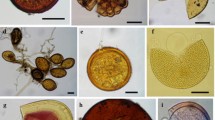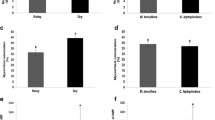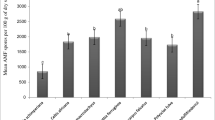Abstract
Gmelina arborea Roxb. (Gmelina, Yemane) is a fast growing tree, native from India and considered as a potentially invasive woody plant in West Africa. Mycorrhizal inoculation of seedlings with Glomus intraradices was performed to study (1) the effect on the growth of G. arborea, (2) the impact on the catabolic diversity of soil microbial communities and (3) the influence on the structure of herbaceous plant species communities in microcosms. Treatments consisted of control plants, pre-planting fertilizer application and arbuscular mycorrhizal (AM) inoculation. After 4 months’ culture in autoclaved soil, G. arborea seedlings were either harvested for growth measurement or transferred into containers filled with the same soil but not sterilized. Other containers were kept without G. arborea seedlings. After 12 months’ further culture, effects of fertilizer amendment and AM inoculation on the growth of G. arborea seedlings were recorded. AM colonization was significantly and positively correlated with plant diversity. The substrate-induced respiration response to carboxylic acids was significantly higher in the absence of G. arborea and in the presence of G. intraradices as compared to the other treatments. The influence of AM symbiosis on plant coexistence and on allelopathic processes of invasive plants are discussed.

Similar content being viewed by others
References
Aarsen WL (1990) Ecological combining ability and competitive combining in plants toward a general evolutionary theory of coexistence in systems of competition. Am Nat 122:707–731
Allen EB, Allen MF (1990) The mediation of competition by mycorrhizae in successional and patchy environments. In: Grace JB, Tilman D (eds) Perspectives in plant competition. Academic Press, New York, pp 367–389
Anderson TH, Domsch KH (1993) The metabolic quotient for CO2 (qCO2) as a specific activity parameter to assess the effects of environmental conditions such as pH, on the microbial biomass of forest soils. Soil Biol Biochem 25: 393–395
Andrade G, Mihara KL, Linderman RG, Bethlenfalvay GJ (1998) Soil aggregation status and rhizobacteria in the mycorrhizosphere. Plant Soil 202:89–96
Azaizeh HA, Marshner H, Römheld V, Wittenmayer L (1995) Effects of a vesicular–arbuscular mycorrhizal fungus and other soil microorganisms on growth, mineral nutrient acquisition and root exudation of soil-grown maize plants. Mycorrhiza 5:321–327
Bethlenfalvay GJ (1992) Mycorrhizae and crop productivity. In: Bethenfalvay GJ, Linderman RG (eds) Mycorrhizae in sustainable agriculture. Am Soc Agron pp 1–27
Bever JD (2002) Host-specificity of AM fungal populations growth rate can generate feed-back on plant growth. Plant Soil 244:281–290
Bever JD, Westover KM, Antonovics J (1997) Incorporating the soil community into plant population dynamics: the utility of a feedback approach. J Ecol 85:561–571
Blum U, Statman KL, Flint LJ, Shaefer SR (2000) Induction and/or selection of phenolic acid-utilizing bulk-soil and rhizospheric bacteria and their influence on phenolic acid phytotoxicity. J Chem Ecol 26:2059–2078
Brown VK, Gange AC (1989) Herbivory by soil dwelling insects depresses plant species richness. Funct Ecol 3:667–671
Brundrett MC, Piche Y, Peterson RL (1985) A developmental study of the early stages in vesicular–arbuscular mycorrhizal formation. Can J Bot 63:184–194
Callaway RM (1995) Positive interactions among plants. Bot Rev 61:306–349
Chiarello N, Hickman JC, Mooney HA (1982) Endomycorrhizal role for interspecific transfer of phosphorus in a community of annual plants. Science 217:941–943
Degens BP, Harris JA (1997) Development of a physiological approach to measuring the catabolic diversity of soil microbial communities. Soil Biol Biochem 29:1309–1320
Dhillion SS, Gardsjord TL (2004) Arbuscular mycorrhizas influence plant diversity, productivity, and nutrients in boreal grasslands. Can J Bot 82:104–114
Duponnois R, Plenchette C (2003) A mycorrhiza helper bacterium (MHB) enhances ectomycorrhizal and endomycorrhizal symbiosis of Australian Acacia species. Mycorrhiza 13:85–91
Duponnois R, Colombet A, Hien V, Thioulouse J (2005) The mycorrhizal fungus Glomus intraradices and rock phosphate amendment influence plant growth and microbial activity in the rhizosphere of Acacia holosericea. Soil Biol Biochem (in press)
Ehrenfeld J, Kourtev P, Huang W (2001) Changes in soil functions following invasions of exotic understory plants in deciduous forests. Ecol Appl 11:1287–1300
Estaun V, Save R, Biel C (1997) AM inoculation as a biological tool to improve plant re-vegetation of a disturbed soil with Rosmarinus officinalis under semi-arid conditions. Appl Soil Ecol 6:223–229
Gillet (1962) Pest pressure, an underestimated factor in evolution. In: systematics, association publication. Taxonomy and geography 4:37–46
Grace JD, Tilman D (eds) (1990) Perspectives on plant competition. Academic Press, San Diego
Graham JH, Leonard RT, Menge JA (1981) Membrane mediated decrease in root exudation responsible for phosphorus inhibition of vesicular–arbuscular mycorrhiza formation. Plant Physiol 68:548–552
Grayston SJ, Campbell CD (1996) Functional biodiversity of microbial communities in the rhizosphere of hybrid larch (Larix eurolepis) and Sitka spruce (Picea sitchensis). Tree Physiol 16:1031–1038
Grayston SJ, Griffith GS, Mawdsley JL, Campbell CD, Bardgett RD (2001) Accounting for variability in soil microbial communities of temperate upland grassland ecosystems. Soil Biol Biochem 33:533–551
Grubb P (1977) The maintenance of species richness in plant communities: the importance of the regeneration niche. Biol Rev 52:107–145
Hart MM, Reader RJ, Klironomos JN (2003) Plant coexistence mediated by arbuscular mycorrhizal fungi. Trends Ecol Evol 18:418–423
Heinemeyer O, Insam H, Kaiser EA, Walenzik G (1989) Soil microbial biomass and respiration measurements: an automated technique based on infrared gas analysis. Plant Soil 116:77–81
Helgason T, Daniell TJ, Husband R, Fitter AH, Young JPW (1998) Ploughing up the wood-wide web? Nature 394:431
Hobbie SE (1992) Effects of plant species on nutrient cycling. Trends Ecol Evol 7:336–339
Huston MA (1977) General hypothesis of species diversity. Am Nat 113:81–101
Janos DP (1980) Mycorrhizae influence tropical succession. Biotropica 12:56–64
Johansson JF, Paul LR, Finlay RD (2004) Microbial interactions in the mycorrhizosphere and their significance for sustainable agriculture. FEMS Microbiol Ecol 48:1–13
John MK (1970) Colorimetric determination in soil and plant material with ascorbic acid. Soil Sci 68:171–177
Kourtev P, Ehrenfeld J, Huang W (1998) Effects of exotic plant species on soil properties in hardwood forests of New Jersey. Water Air Soil Pollut 105:493–501
Kourtev P, Huang W, Ehrenfeld J (1999) Differences in earthworm densities and nitrogen dynamics in soils under exotic and native plant species. Biol Inv 1:237–245
Kourtev P, Ehrenfeld J, Häggblom M (2003) Experimental analysis of the effect of exotic and native plant species on the structure and function of soil microbial communities. Soil Biol Biochem 35:895–905
Krebs CJ (1989) Ecology methodology. Harper Collins Publishers, New York
Linderman RG (1988) Mycorrhizal interactions with the rhizosphere microflora: the mycorrhizosphere effect. Phytopathology 78:366–371
Lonsdale WM (1999) Global patterns of plant invasions and the concept of invisibility. Ecology 80:1522–1536
Mack RN, Simberloff D, Lonsdale WM, Evans H, Clout M, Bazzaz FA (2000) Biotic invasions: causes, epidemiology, global consequences, and control. Ecol Appl 10:689–710
Magurran AE (ed) (1988) Ecological diversity and its measurement. Croom Helm, London
Marshner P, Crowley DE, Higashi M (1997) Root exudation and physiological status of a root-colonizing fluorescent pseudomonad in mycorrhizal and non-mycorrhizal pepper (Capsicum annuum L.). Plant Soil 189:11–20
Mc Gee P (1989) Variations in propagules number of vesicular–arbuscular mycorrhizal fungi in a semi-arid soil. New Phytol 92:28–33
Meyer O (1994) Functional groups of micro-organisms. In: Schulze ED, Money H (eds) Biodiversity and ecosystem function. Springer, Berlin Heidelberg New York, pp 67–97
Mosse B (1986) Mycorrhiza in a sustainable agriculture. Biol Agric Hortic 3:191–220
O’Connor PJ, Smith SE, Smith FA (2002) Arbuscular mycorrhizas influence plant diversity and community structure in a semiarid herbland. New Phytol 154:209–219
Pellissier F, Souto XC (1999) Allelopathy in Northern temperate and boreal semi-natural woodland. Crit Rev Plant Sci 18:637–652
Phillips JM, Hayman DS (1970) Improved procedures for clearing roots and staining parasitic and vesicular–arbuscular mycorrhizal fungi for rapid assessment of infection. Trans Br Mycol Soc 55:158–161
Plenchette C, Declerck S, Diop T, Strullu DG (1996) Infectivity of monoaxenic subcultures of the AM fungus Glomus versiforme associated with Ri-TDNA transformed root. Appl Microbiol Biotechnol 46:545–548
Priha O, Grayston SJ, Pennanen T, Smolander A (1999) Microbial activities related to C and N cycling and microbial community structure in the rhizosphere of Pinus sylvestris, Picea abies and Betula pendula seedlings in an organic and mineral soil. FEMS Microbiol Ecol 30:187–199
Ravnskov S, Larsen J, Olsson PA, Jakobsen I (1999) Effects of various organic compounds on growth and phosphorus uptake of an arbuscular mycorrhizal fungus. New Phytol 141:517–524
Renne IJ, Rios BG, Fehmi JS, Tracy BF (2004) Low allelopathic potential of an invasive forage grass on native grassland plants: a cause for encouragement? Basic Appl Ecol 5:261–269
Ricklefs RW (1977) Environmental heterogeneity and plant species diversity: a hypothesis. Am Nat 111:376–381
Ridenour WM, Callaway RM (2001) The relative importance of allelopathy in interference: the effects of an invasive weed on a native brunchgrass. Oecologia 126:444–450
Sakai AK, Allendorf FW, Holt JS, Lodge DM, Molofsky J, With KA, Baughman S, Cabin RJ, Cohen JE, Ellstrand NC, Mc Cauley DE, O’Neil P, Parker IM, Thompson JN, Weller SG (2001) The population biology of invasive species. Annu Rev Ecolog Syst 32:305–332
Schreiner RP, Mihara KL, Mc Daniel H, Benthlenfalvay GJ (2003) Mycorrhizal fungi influence plant and soil functions and interactions. Plant Soil 188:199–209
Selosse MA, Baudoin E, Vanderkoornhuyse P (2004) Symbiotic microorganisms, a key for ecological success and protection of plants. Cr Acad Sci III Vie 327:639–648
Shachar-Hill Y, Pfeffer PE, Douds D, Osman SF, Doner LW, Ratcliffe RG (1995) Partitioning of intermediary carbon metabolism in vesicular–arbuscular mycorrhizal leeks. Plant Physiol 108:7–15
St John TV, Coleman DC, Reid CPP (1983). Association of vesicular–arbuscular mycorrhizal (VAM) fungi with soil organic matter. Ecology 64:957–959
Stotzky G (1997) Soil as an environment for microbial life. In: Van Elsas JD, Trevors JT, Wellington EMH (eds) Modern soil microbiology. Dekker, New York, pp 1–20
Sylvia DM (1990) Inoculation of native woody plants with vesicular–arbuscular mycorrhizal fungi for phosphate mine lands reclamation. Agric Ecosyst Environ 31:253–261
Tilman D (1982) Resource competition and community structure. Monographs in population biology, vol 17. Princeton University Press, Princeton
Urcelay C, Diaz S (2003) The mycorrhizal dependence of subordinates determines the effect of arbuscular mycorrhizal fungi on plant diversity. Ecol Lett 6:388–391
van der Heijden MGA, Klironomos JN, Ursic M, Moutoglis P, Streitwolf-Engel R, Boller T, Wiemken A, Sanders IR (1998) Mycorrhizal fungal diversity determines plant biodiversity ecosystem variability and productivity. Nature 396:69–72
Vaughn SF, Berhow MA (1999) Allelochemicals isolated from tissues of an invasive weed garlic mustard (Alliaria petioloata). J Chem Ecol 25:2495–2504
Villenave C, Leye K, Chotte JL, Duponnois R (2003) Nematofauna associated with the mycorrhizosphere and hyphosphere of Glomus intraradices and exotic or native leguminous plant species mycorrhizal formation in West Africa. Biol Fertil Soils 38:161–169
Watkinson AR, Freckleton RP (1997) Quantifying the impact of arbuscular mycorrhizal fungi on plant competition. J Ecol 85:541–545
West HM (1996) Influence of arbuscular mycorrhizal competition between Holcus lanatus and Dactylis glomerata. J Ecol 84:429–438
West AW, Sparling GP (1986) Modifications to the substrate-induced respiration method to permit measurements of microbial biomass in soils of differing water contents. J Microbiol Methods 5:177–189
Westover KM, Kennedy AC, Kelley SE (1997) Patterns of rhizosphere microbial community structure associated with co-occuring plant species. J Ecol 85:863–873
Whittaker RH, Feeny PP (1971) Allelochemicals: chemical interactions between species. Science 171:757–770
Wirsel SGR (2004) Homogenous stands of a wetland grass harbour dicerse consortia of arbuscular mycorrhizal fungi. FEMS Microb Ecol 48:129–138
Author information
Authors and Affiliations
Corresponding author
Rights and permissions
About this article
Cite this article
Sanon, A., Martin, P., Thioulouse, J. et al. Displacement of an herbaceous plant species community by mycorrhizal and non-mycorrhizal Gmelina arborea, an exotic tree, grown in a microcosm experiment. Mycorrhiza 16, 125–132 (2006). https://doi.org/10.1007/s00572-005-0024-7
Received:
Accepted:
Published:
Issue Date:
DOI: https://doi.org/10.1007/s00572-005-0024-7




